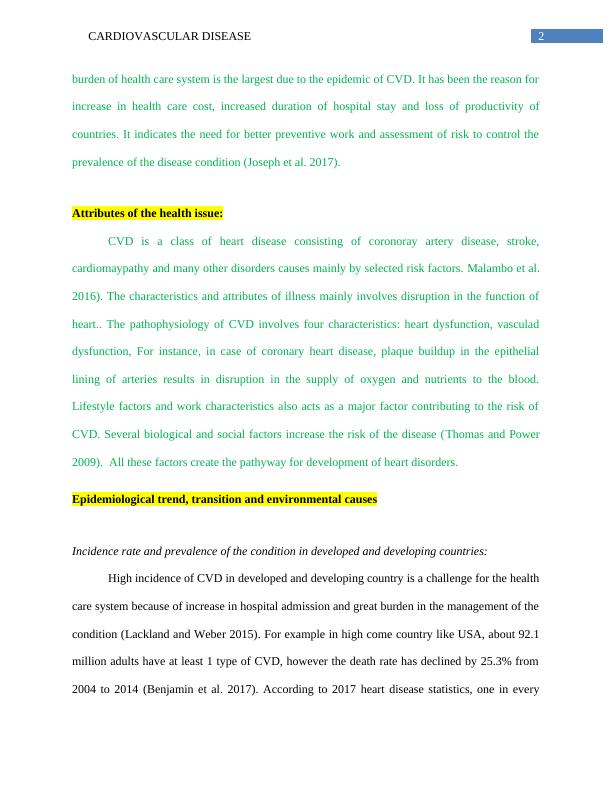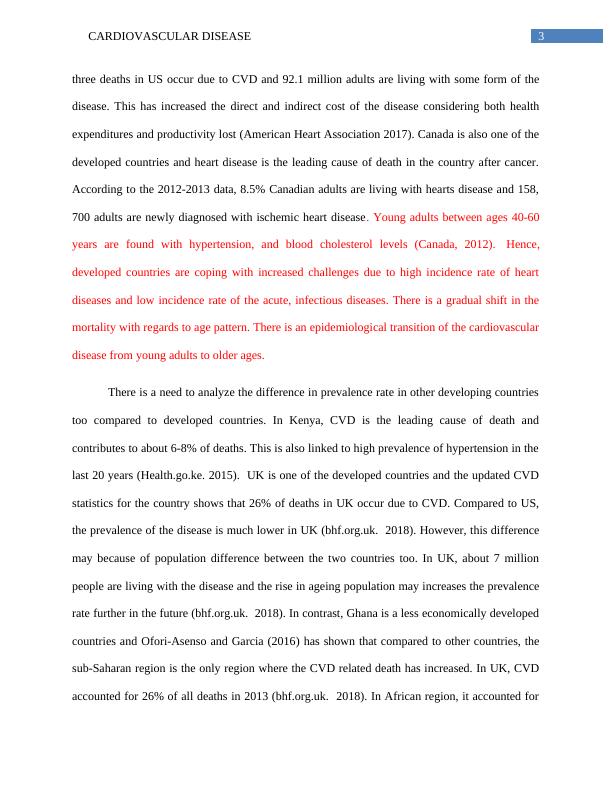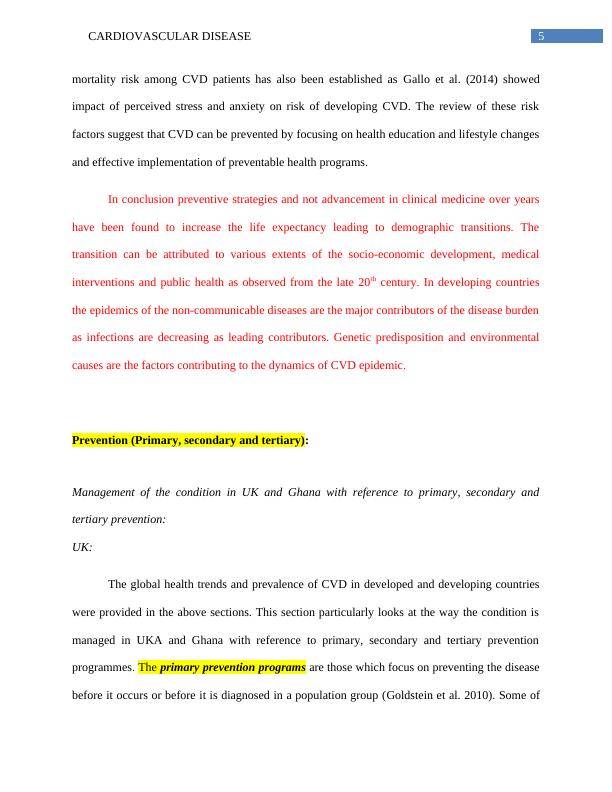Cardiovascular Disease: Global Trends, Prevalence, and Management
21 Pages6253 Words76 Views
Added on 2023-06-15
About This Document
This report analyzes global trends related to prevalence and transmission of cardiovascular diseases (CVD) as it is a great disease burden worldwide. It provides an insight into incidence rate of disease in developing countries and management of the condition particularly in UK and Ghana. An evaluation of preventive work contributing to assessment of risk and management of the condition and analysis of the health care system is also presented to understand the impact on population change.
Cardiovascular Disease: Global Trends, Prevalence, and Management
Added on 2023-06-15
ShareRelated Documents
Running head: CARDIOVASCULAR DISEASE
Cardiovascular disease
Name of the student:
Name of the University:
Author’s note
Cardiovascular disease
Name of the student:
Name of the University:
Author’s note

1CARDIOVASCULAR DISEASE
Introduction:
Non-communicable disease (NCDs) is a major health burden in developing countries and
accounts for about 40 million deaths each year. The burden of four main types of NCDs such as
cancer, chronic respiratory disease, diabetes and cancer is increasing not only in developing
countries but also in low and middle income countries. About 80% of premature NCD death is
caused by the above four types of NCDs and among them cardiovascular diseases (CVD) is the
leading cause of death (World Health Organization 2017). This report is specifically focused on
analyzing global trends related to prevalence and transmission of CVD as it is a great disease
burden worldwide. It is a major cause of disability and contributes to escalating health care cost
too (Bauer et al. 2014). Hence, to get an insight into ways to reduce disability and death due to
CVD, critical examination of the occurrence and management of the condition is necessary. This
report provides an insight into incidence rate of disease in developing countries and management
of the condition particularly in UK and Ghana. An evaluation of preventive work contributing to
assessment of risk and management of the condition and analysis of the health care system is
also presented to understand the impact on population change.
Reasons for CVD as a global health issue:
CVD is regarded as global health issue because it is the leading cause of death and
mortality worldwide. The WHO report suggests that people are mostly dying from CVD than
any other disease. 17.7 million people die from CVD every year and among them, 17.4 million
were caused due to coronary heart diseases. This accounts to about 31% of all global deaths
(World Health Organization 2017). CVD related deaths are seen not only in developed countries
but also in low and middle income countries. Hence, from this statistics, it can be said that
Introduction:
Non-communicable disease (NCDs) is a major health burden in developing countries and
accounts for about 40 million deaths each year. The burden of four main types of NCDs such as
cancer, chronic respiratory disease, diabetes and cancer is increasing not only in developing
countries but also in low and middle income countries. About 80% of premature NCD death is
caused by the above four types of NCDs and among them cardiovascular diseases (CVD) is the
leading cause of death (World Health Organization 2017). This report is specifically focused on
analyzing global trends related to prevalence and transmission of CVD as it is a great disease
burden worldwide. It is a major cause of disability and contributes to escalating health care cost
too (Bauer et al. 2014). Hence, to get an insight into ways to reduce disability and death due to
CVD, critical examination of the occurrence and management of the condition is necessary. This
report provides an insight into incidence rate of disease in developing countries and management
of the condition particularly in UK and Ghana. An evaluation of preventive work contributing to
assessment of risk and management of the condition and analysis of the health care system is
also presented to understand the impact on population change.
Reasons for CVD as a global health issue:
CVD is regarded as global health issue because it is the leading cause of death and
mortality worldwide. The WHO report suggests that people are mostly dying from CVD than
any other disease. 17.7 million people die from CVD every year and among them, 17.4 million
were caused due to coronary heart diseases. This accounts to about 31% of all global deaths
(World Health Organization 2017). CVD related deaths are seen not only in developed countries
but also in low and middle income countries. Hence, from this statistics, it can be said that

2CARDIOVASCULAR DISEASE
burden of health care system is the largest due to the epidemic of CVD. It has been the reason for
increase in health care cost, increased duration of hospital stay and loss of productivity of
countries. It indicates the need for better preventive work and assessment of risk to control the
prevalence of the disease condition (Joseph et al. 2017).
Attributes of the health issue:
CVD is a class of heart disease consisting of coronoray artery disease, stroke,
cardiomaypathy and many other disorders causes mainly by selected risk factors. Malambo et al.
2016). The characteristics and attributes of illness mainly involves disruption in the function of
heart.. The pathophysiology of CVD involves four characteristics: heart dysfunction, vasculad
dysfunction, For instance, in case of coronary heart disease, plaque buildup in the epithelial
lining of arteries results in disruption in the supply of oxygen and nutrients to the blood.
Lifestyle factors and work characteristics also acts as a major factor contributing to the risk of
CVD. Several biological and social factors increase the risk of the disease (Thomas and Power
2009). All these factors create the pathyway for development of heart disorders.
Epidemiological trend, transition and environmental causes
Incidence rate and prevalence of the condition in developed and developing countries:
High incidence of CVD in developed and developing country is a challenge for the health
care system because of increase in hospital admission and great burden in the management of the
condition (Lackland and Weber 2015). For example in high come country like USA, about 92.1
million adults have at least 1 type of CVD, however the death rate has declined by 25.3% from
2004 to 2014 (Benjamin et al. 2017). According to 2017 heart disease statistics, one in every
burden of health care system is the largest due to the epidemic of CVD. It has been the reason for
increase in health care cost, increased duration of hospital stay and loss of productivity of
countries. It indicates the need for better preventive work and assessment of risk to control the
prevalence of the disease condition (Joseph et al. 2017).
Attributes of the health issue:
CVD is a class of heart disease consisting of coronoray artery disease, stroke,
cardiomaypathy and many other disorders causes mainly by selected risk factors. Malambo et al.
2016). The characteristics and attributes of illness mainly involves disruption in the function of
heart.. The pathophysiology of CVD involves four characteristics: heart dysfunction, vasculad
dysfunction, For instance, in case of coronary heart disease, plaque buildup in the epithelial
lining of arteries results in disruption in the supply of oxygen and nutrients to the blood.
Lifestyle factors and work characteristics also acts as a major factor contributing to the risk of
CVD. Several biological and social factors increase the risk of the disease (Thomas and Power
2009). All these factors create the pathyway for development of heart disorders.
Epidemiological trend, transition and environmental causes
Incidence rate and prevalence of the condition in developed and developing countries:
High incidence of CVD in developed and developing country is a challenge for the health
care system because of increase in hospital admission and great burden in the management of the
condition (Lackland and Weber 2015). For example in high come country like USA, about 92.1
million adults have at least 1 type of CVD, however the death rate has declined by 25.3% from
2004 to 2014 (Benjamin et al. 2017). According to 2017 heart disease statistics, one in every

3CARDIOVASCULAR DISEASE
three deaths in US occur due to CVD and 92.1 million adults are living with some form of the
disease. This has increased the direct and indirect cost of the disease considering both health
expenditures and productivity lost (American Heart Association 2017). Canada is also one of the
developed countries and heart disease is the leading cause of death in the country after cancer.
According to the 2012-2013 data, 8.5% Canadian adults are living with hearts disease and 158,
700 adults are newly diagnosed with ischemic heart disease. Young adults between ages 40-60
years are found with hypertension, and blood cholesterol levels (Canada, 2012). Hence,
developed countries are coping with increased challenges due to high incidence rate of heart
diseases and low incidence rate of the acute, infectious diseases. There is a gradual shift in the
mortality with regards to age pattern. There is an epidemiological transition of the cardiovascular
disease from young adults to older ages.
There is a need to analyze the difference in prevalence rate in other developing countries
too compared to developed countries. In Kenya, CVD is the leading cause of death and
contributes to about 6-8% of deaths. This is also linked to high prevalence of hypertension in the
last 20 years (Health.go.ke. 2015). UK is one of the developed countries and the updated CVD
statistics for the country shows that 26% of deaths in UK occur due to CVD. Compared to US,
the prevalence of the disease is much lower in UK (bhf.org.uk. 2018). However, this difference
may because of population difference between the two countries too. In UK, about 7 million
people are living with the disease and the rise in ageing population may increases the prevalence
rate further in the future (bhf.org.uk. 2018). In contrast, Ghana is a less economically developed
countries and Ofori-Asenso and Garcia (2016) has shown that compared to other countries, the
sub-Saharan region is the only region where the CVD related death has increased. In UK, CVD
accounted for 26% of all deaths in 2013 (bhf.org.uk. 2018). In African region, it accounted for
three deaths in US occur due to CVD and 92.1 million adults are living with some form of the
disease. This has increased the direct and indirect cost of the disease considering both health
expenditures and productivity lost (American Heart Association 2017). Canada is also one of the
developed countries and heart disease is the leading cause of death in the country after cancer.
According to the 2012-2013 data, 8.5% Canadian adults are living with hearts disease and 158,
700 adults are newly diagnosed with ischemic heart disease. Young adults between ages 40-60
years are found with hypertension, and blood cholesterol levels (Canada, 2012). Hence,
developed countries are coping with increased challenges due to high incidence rate of heart
diseases and low incidence rate of the acute, infectious diseases. There is a gradual shift in the
mortality with regards to age pattern. There is an epidemiological transition of the cardiovascular
disease from young adults to older ages.
There is a need to analyze the difference in prevalence rate in other developing countries
too compared to developed countries. In Kenya, CVD is the leading cause of death and
contributes to about 6-8% of deaths. This is also linked to high prevalence of hypertension in the
last 20 years (Health.go.ke. 2015). UK is one of the developed countries and the updated CVD
statistics for the country shows that 26% of deaths in UK occur due to CVD. Compared to US,
the prevalence of the disease is much lower in UK (bhf.org.uk. 2018). However, this difference
may because of population difference between the two countries too. In UK, about 7 million
people are living with the disease and the rise in ageing population may increases the prevalence
rate further in the future (bhf.org.uk. 2018). In contrast, Ghana is a less economically developed
countries and Ofori-Asenso and Garcia (2016) has shown that compared to other countries, the
sub-Saharan region is the only region where the CVD related death has increased. In UK, CVD
accounted for 26% of all deaths in 2013 (bhf.org.uk. 2018). In African region, it accounted for

4CARDIOVASCULAR DISEASE
9.2% of all deaths in 2013. More than 50% of the death in Africa occurs in people above 30-69
years of age. It is also estimated that burden of CVD will rise and double by 2020 compared to
1990. Ghana has been identified as the second largest city with high rate of admission due to
heart disease and stroke. In 2011, stroke was declared as the third leading cause of death in the
city (Ofori-Asenso and Garcia 2016). There is a need to analyze the difference in management
of CVD in developed and developing countries to see how treatment outcomes and preventive
conditions different in these regions led to epidemiological transition.
Environmental causes:
Many environmental factors is major risk factor CVD. For instance, exposure to tobacco
smoke is strongly associated with CVD risk and mortality. Alcohol consumption, tobacco use,
and unhealthy diet are some of the environmental risk factors contributing to CVD (World
Health Organization. 2017). Such behaviors have an impact on both morbidity and mortality of
the disease. Exposure to chemicals like metals and hydrocarbons also affects blood pressure
regulation and elevate the risk of CVD. These factors advances disease and the
pathophysiological process associated with CVD (Cosselman, Navas-Acien and Kaufman 2015).
Grover et al. (2016) showed that lifestyle factors like excess body weight increases risk
of CVD and adapting healthy lifestyle is necessary for such people. Presence of clinical
conditions like hypertension and diabetes also increases the risk of CVD (Peters, Huxley and
Woodward 2014; Buendia et al. 2017). Human and biological factors like age, gender, ethnicity
and race are important determinant increasing the prevalence of the disease (Kumar 2017).
Hence, people from different racial groups and those with family history of CVD are two-three
times more likely to be affected by the disease. Psychological links to increase in morbidity and
9.2% of all deaths in 2013. More than 50% of the death in Africa occurs in people above 30-69
years of age. It is also estimated that burden of CVD will rise and double by 2020 compared to
1990. Ghana has been identified as the second largest city with high rate of admission due to
heart disease and stroke. In 2011, stroke was declared as the third leading cause of death in the
city (Ofori-Asenso and Garcia 2016). There is a need to analyze the difference in management
of CVD in developed and developing countries to see how treatment outcomes and preventive
conditions different in these regions led to epidemiological transition.
Environmental causes:
Many environmental factors is major risk factor CVD. For instance, exposure to tobacco
smoke is strongly associated with CVD risk and mortality. Alcohol consumption, tobacco use,
and unhealthy diet are some of the environmental risk factors contributing to CVD (World
Health Organization. 2017). Such behaviors have an impact on both morbidity and mortality of
the disease. Exposure to chemicals like metals and hydrocarbons also affects blood pressure
regulation and elevate the risk of CVD. These factors advances disease and the
pathophysiological process associated with CVD (Cosselman, Navas-Acien and Kaufman 2015).
Grover et al. (2016) showed that lifestyle factors like excess body weight increases risk
of CVD and adapting healthy lifestyle is necessary for such people. Presence of clinical
conditions like hypertension and diabetes also increases the risk of CVD (Peters, Huxley and
Woodward 2014; Buendia et al. 2017). Human and biological factors like age, gender, ethnicity
and race are important determinant increasing the prevalence of the disease (Kumar 2017).
Hence, people from different racial groups and those with family history of CVD are two-three
times more likely to be affected by the disease. Psychological links to increase in morbidity and

5CARDIOVASCULAR DISEASE
mortality risk among CVD patients has also been established as Gallo et al. (2014) showed
impact of perceived stress and anxiety on risk of developing CVD. The review of these risk
factors suggest that CVD can be prevented by focusing on health education and lifestyle changes
and effective implementation of preventable health programs.
In conclusion preventive strategies and not advancement in clinical medicine over years
have been found to increase the life expectancy leading to demographic transitions. The
transition can be attributed to various extents of the socio-economic development, medical
interventions and public health as observed from the late 20th century. In developing countries
the epidemics of the non-communicable diseases are the major contributors of the disease burden
as infections are decreasing as leading contributors. Genetic predisposition and environmental
causes are the factors contributing to the dynamics of CVD epidemic.
Prevention (Primary, secondary and tertiary):
Management of the condition in UK and Ghana with reference to primary, secondary and
tertiary prevention:
UK:
The global health trends and prevalence of CVD in developed and developing countries
were provided in the above sections. This section particularly looks at the way the condition is
managed in UKA and Ghana with reference to primary, secondary and tertiary prevention
programmes. The primary prevention programs are those which focus on preventing the disease
before it occurs or before it is diagnosed in a population group (Goldstein et al. 2010). Some of
mortality risk among CVD patients has also been established as Gallo et al. (2014) showed
impact of perceived stress and anxiety on risk of developing CVD. The review of these risk
factors suggest that CVD can be prevented by focusing on health education and lifestyle changes
and effective implementation of preventable health programs.
In conclusion preventive strategies and not advancement in clinical medicine over years
have been found to increase the life expectancy leading to demographic transitions. The
transition can be attributed to various extents of the socio-economic development, medical
interventions and public health as observed from the late 20th century. In developing countries
the epidemics of the non-communicable diseases are the major contributors of the disease burden
as infections are decreasing as leading contributors. Genetic predisposition and environmental
causes are the factors contributing to the dynamics of CVD epidemic.
Prevention (Primary, secondary and tertiary):
Management of the condition in UK and Ghana with reference to primary, secondary and
tertiary prevention:
UK:
The global health trends and prevalence of CVD in developed and developing countries
were provided in the above sections. This section particularly looks at the way the condition is
managed in UKA and Ghana with reference to primary, secondary and tertiary prevention
programmes. The primary prevention programs are those which focus on preventing the disease
before it occurs or before it is diagnosed in a population group (Goldstein et al. 2010). Some of

End of preview
Want to access all the pages? Upload your documents or become a member.
Related Documents
Australia’s Achievements and Challenges in Combating Cardiovascular Diseaselg...
|12
|3932
|1
Non-Communicable Disease Burdenlg...
|11
|3460
|181
Prevalence of Cardiovascular Diseases in Elderly People in Australialg...
|15
|3653
|295
Epidemiologic Transition and Spread of Non-Communicable Diseaselg...
|9
|3770
|1
Coronary Artery Diseaselg...
|17
|4584
|66
Cardiovascular Diseaselg...
|7
|1450
|39
